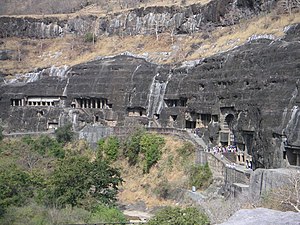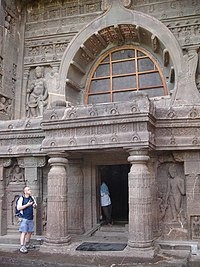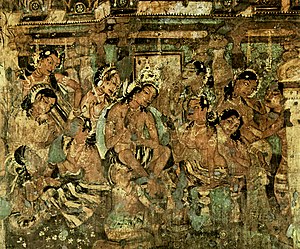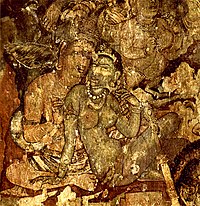 AJANTA is one of the world's greatest historical monument recognised by UNESCO.These caves were discovered in AD 1819 and were built up in the earlier 2nd century BC-AD. Most of the paintings in Ajanta are right from 2nd century BC-AD and some of them about the fifth century AD and continued for the next two centuries. All paintings shows heavy religious influence and centre around Buddha, Bodhisattvas, incidents from the life of Buddha and the Jatakas. The paintings are executed on a ground of mud-plaster in the tempera technique.
AJANTA is one of the world's greatest historical monument recognised by UNESCO.These caves were discovered in AD 1819 and were built up in the earlier 2nd century BC-AD. Most of the paintings in Ajanta are right from 2nd century BC-AD and some of them about the fifth century AD and continued for the next two centuries. All paintings shows heavy religious influence and centre around Buddha, Bodhisattvas, incidents from the life of Buddha and the Jatakas. The paintings are executed on a ground of mud-plaster in the tempera technique.
The caves are in a wooded and rugged horseshoe-shaped ravine about 3½ km from the village of Ajintha. It is situated in the Aurang?b?d district of Maharashtra State in India (106 kilometers away from the city of Aurangabad).
In the early 19th century (year 1819) some British soldiers were out hunting in the Deccan plateau. One of them suddenly saw, from a height, a horseshoe rock; His curiosity aroused by the entrance of a cave.
 .All the rock-cut caves had paintings on verandahs, inner walls and ceilings, these revealed some of the most beautiful masterpieces of world art. In the grottos were also symbolic Buddhist mounds called Stupas, and cells for monks called viharas. There were giant sculptures of Buddha's, Bodhisattvas (potential Buddha's), or Taras (female Buddhist divinities), as also dwarapalas (doorkeepers). Later, an inscription was found of King Harisena ('moon among princes'), of the Vakataka dynasty of the 5th -6th century A.D. in cave No.17. It seems that the local Vakatakas had relations, thought marriage, with the great Gupta kings of the north.
.All the rock-cut caves had paintings on verandahs, inner walls and ceilings, these revealed some of the most beautiful masterpieces of world art. In the grottos were also symbolic Buddhist mounds called Stupas, and cells for monks called viharas. There were giant sculptures of Buddha's, Bodhisattvas (potential Buddha's), or Taras (female Buddhist divinities), as also dwarapalas (doorkeepers). Later, an inscription was found of King Harisena ('moon among princes'), of the Vakataka dynasty of the 5th -6th century A.D. in cave No.17. It seems that the local Vakatakas had relations, thought marriage, with the great Gupta kings of the north.
The total numbers of caves are 29. Most of them were finished, a few were half finished, a pathway, scooped out from stone, runs as a crescent by the caves for pedestrians. From this, one can have a glorious view of the ravine below.
At Ajanta, the paintings on the walls, illustrate the events in the life of prince Gautama
Buddha, the founder of Buddhism and in the more popular Jatakas stories pertaining to Buddha's previous incarnation. . According to the older conceptions, the Buddha wrought many deeds of kindness and mercy in a long series of transmigration as a Bodhisattva, before achieving his final birth as the sage of sakyas.Incidentally they contain the scenes of semi-mythological history, the royal court and popular life of the ancient times, as told in romances and plays. Some pictures recall the Greek and Roman compositions and proportions, few late resemble to Chinese manners to some extent. But majority belongs to a phase, which is purely Indian, as they are found nowhere else. These monuments were constructed during two different periods of time separated by a long interval of four centuries.
. According to the older conceptions, the Buddha wrought many deeds of kindness and mercy in a long series of transmigration as a Bodhisattva, before achieving his final birth as the sage of sakyas.Incidentally they contain the scenes of semi-mythological history, the royal court and popular life of the ancient times, as told in romances and plays. Some pictures recall the Greek and Roman compositions and proportions, few late resemble to Chinese manners to some extent. But majority belongs to a phase, which is purely Indian, as they are found nowhere else. These monuments were constructed during two different periods of time separated by a long interval of four centuries. >. The older ones were the product of last to centuries before Christ and belong to Hinayana period of Buddhism in later part of 2nd century AD when Buddhism was divided into two sections, after the conduct of the fourth general council under another great king, Kanishka.
>. The older ones were the product of last to centuries before Christ and belong to Hinayana period of Buddhism in later part of 2nd century AD when Buddhism was divided into two sections, after the conduct of the fourth general council under another great king, Kanishka.
It is thought that the craftsmen who painted and sculpted in the Ajanta caves, were mostly Buddhist monks Perhaps many Hindu craftsmen of the lower castes had accepted the faith of the Buddha, the Craftsmen, in those days, were grouped together according to their profession, they learnt their skill from father to son and son to son. Some of them were great masters, who invented new techniques new tools and new ways of handling paint and chisel, in every generation.
The Ajanta cave temples in continuation from similar rock-cut shines in the Western Ghats and the Deccan. They are of two different kinds:Some of them are Chaiity halls, for group worship as in Bhaja, Karla, and Kanheri. In the Chaitya hall caves (8,9,10,12 & 13), there are symbolic stupas.
 . The hall was an essential element of a viharas. In the Vakataka phase, early viharas were not intended to have shrines because they were purely meant to be halls of residence and congregation. Later, shrines were introduced in them in the back walls, which became a norm. The shrines were made to house the central object of reverence that is the image of the Buddha often seated in the dharmachakrapravartana mudra (the gesture of teaching). In the caves with latest features, we find subsidiary shrines added on the side walls, porch or the front-court. The facades of many vih?ras are decorated with carvings, and walls and ceilings were often covered with paintings.
. The hall was an essential element of a viharas. In the Vakataka phase, early viharas were not intended to have shrines because they were purely meant to be halls of residence and congregation. Later, shrines were introduced in them in the back walls, which became a norm. The shrines were made to house the central object of reverence that is the image of the Buddha often seated in the dharmachakrapravartana mudra (the gesture of teaching). In the caves with latest features, we find subsidiary shrines added on the side walls, porch or the front-court. The facades of many vih?ras are decorated with carvings, and walls and ceilings were often covered with paintings.
